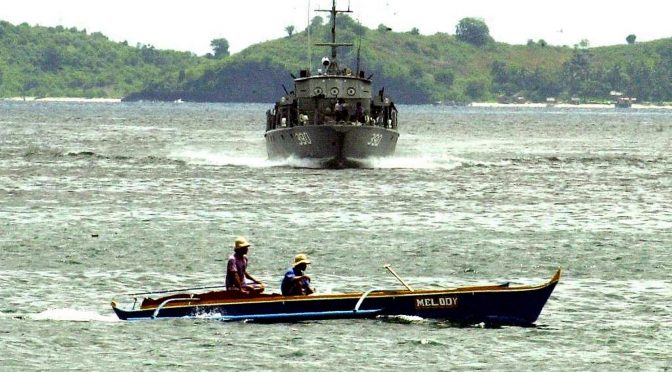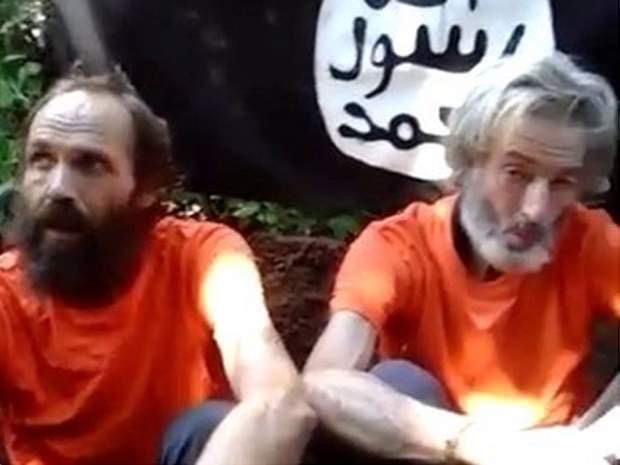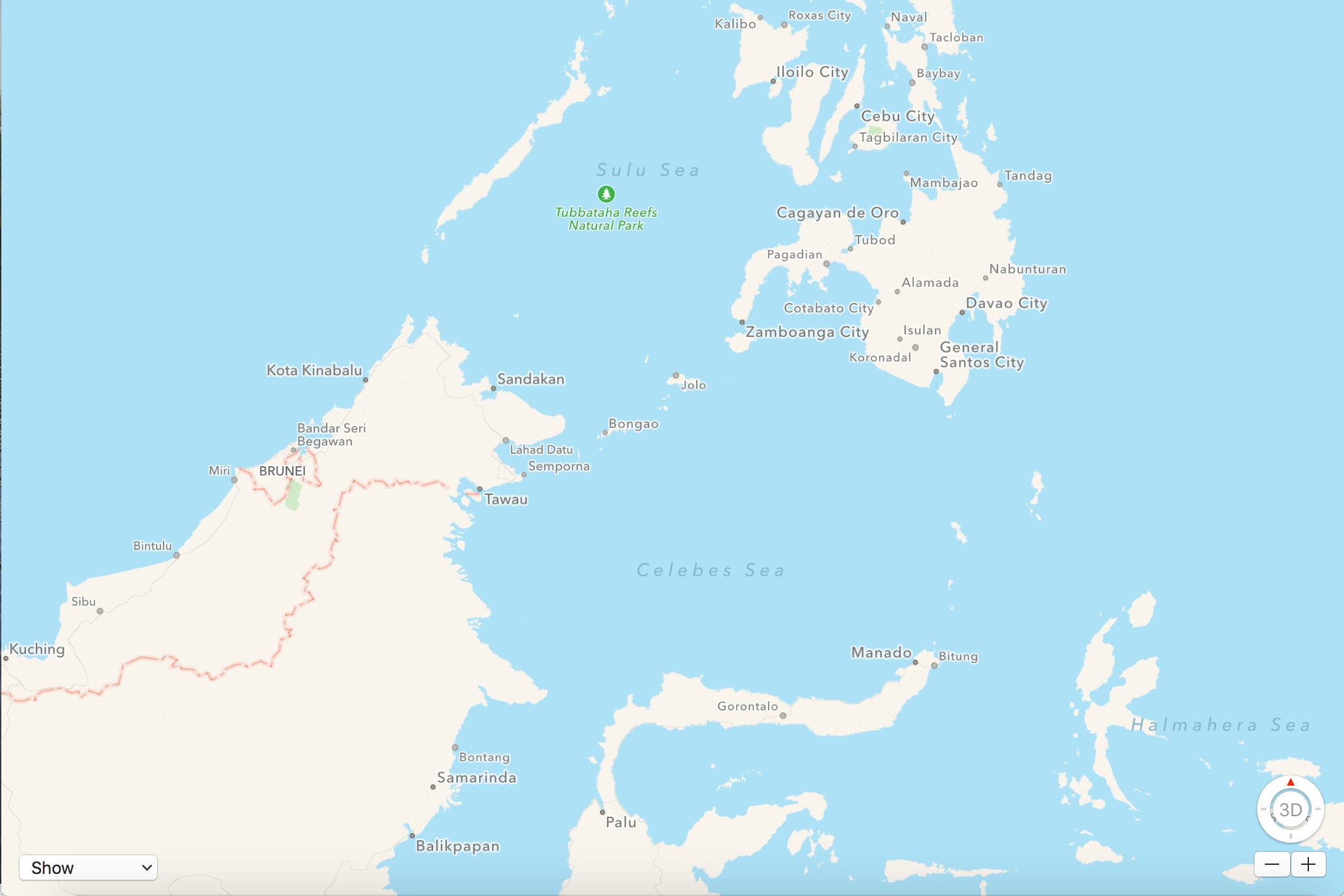
A spate of shipjackings and kidnapping-for-ransoms has imperiled regional trade in Southeast Asia and prompted calls for trilateral maritime policing in the waters between the
The Context
Starting on 26 March 2016, militants from the Abu Sayyaf
Group (ASG) began a spate of maritime
kidnappings. Three Indonesian vessels and a Malaysian tugboat were
hijacked, and some 18 sailors were taken hostage.

A screen capture from Abu Sayyaf’s fifth video of Norwegian,
Kjartan Sekkingstad (l), and Canadian, Robert Hall (r), released on 14 May 2016
Their treatment was very different than the three Western
hostages abducted from a Davao

Photograph of the four Malaysian sailors, released via
Facebook, on 15 April 2016
The Malaysian and Indonesian sailors, by contrast, were
quickly put in contact with their families and companies to arrange ransom
payments. Although the ASG threatened to behead the four Malaysian sailors if no
ransom was paid, there was no IS imagery in the photo posted on Facebook in
the proof of life picture that the ASG released. In all three cases,
ransoms were paid and the suspects released. Various press reports indicate
that the four Malaysians were released with the payment of 140
million pesos ($2.97 million), while ten Indonesians were
released following a 50
million pesos ($1.06 million) ransom, and the final four released with
a 15
million pesos ($319,000) ransom. The payment of ransoms was always
officially denied.
While governments may have not paid the ransom, family members, shipping firms,
friends, and insurance companies appear to have come up with the requisite
funds. Malaysian Home Minister Ahmad Zahid Hamidi acknowledged that money changed
hands, but “channeled not as ransom, but to a body in the Philippines
Not surprisingly, with the payment of large ransoms,
shipjackings/kidnappings have continued. On 20 June another Indonesian
tugboat was boarded and seven of its thirteen crew members taken hostage.
Though the remaining six were able to steer the ship to a safe port, the ASG
is demanding $4.8
million in ransom for the release of the seven. Within days of
the hijacking the captain was able to call
his wife and convey the ransom demand.
The Costs
These shipjackings/maritime kidnappings imperil regional
trade. While only a small amount of the $40
billion in regional maritime trade passes through these waters, it
is not insignificant. Indonesian coal exports from East
Kalimantan account for 70 percent of total Philippine coal
imports, worth over $800
million. There are an estimated 55
million metric tons of goods that transit these waters
annually. These exports are all the more important as Chinese imports of raw
materials from Southeast Asia continue to fall with China Philippines Philippines
from Indonesian ports, “The moratorium on coal exports to the Philippines will be extended until there is a
guarantee for security from the Philippines
Calls for Trilateral Maritime Policing
For the first time in many years, Malaysian and Indonesian
leaders have been speaking of the Southern Philippines as being the weak
link in regional security and began to call for trilateral maritime
policing in waters to the north and northeast of Sabah .
There was a most un-ASEAN drumbeat of threats by Indonesian civilian and
military leaders to engage in unilateral
military operations to rescue their sailors. On 27 April, Philippine
President Aquino acquiesced
to Indonesian and Malaysian calls for joint maritime patrols based on the joint
operations in the Strait of Malacca .
On 5 May, the three foreign ministers met and issued a communique “recognized
the growing security challenges, such as those arising from armed robbery
against ships, kidnapping, transnational crimes and terrorism in the region,
particularly in reference to the maritime areas of common concern.”
To conduct patrol among the three countries using existing
mechanisms as a modality;
To render immediate assistance for the safety of people and
ships in distress within the maritime areas of common concern;
To establish a national focal point among the three
countries to facilitate timely sharing of information and intelligence as well
as coordination in the event of emergency and security threats; and,
To establish a hotline of communication among the three
countries to better facilitate coordination during emergency situations and
security threats.
They instruct the relevant agencies of the three countries
to meet as soon as possible and subsequently convene on a regular basis to
implement and periodically review the above-mentioned measures and also to
formulate the Standard Operating Procedure (SOP).
With the agreement in principle, the sides had to negotiate
a standard operating procedure, which had to have more teeth than a
poorly implemented 2002 trilateral agreement to respond to Abu
Sayyaf attacks.
On 20 June, the Malaysian, Indonesian, and Philippine
Defense Ministers agreed to establish transit
corridors. “The ministers have agreed in principle to explore the
following measures, including a transit corridor within the maritime areas of
common concern, which will serve as designated sea lanes for mariners,” they
said in a joint statement. In addition, they pledged to increase the number of
air and sea patrols as well as maritime escorts.
Most controversially, the draft SOP will allow for the right
of hot pursuit, something that the Indonesians insisted on. The Indonesian
Minister of Defense, Ryamizard Ryacudu told the media
“We’ve agreed that if another hostage situation occurs, we will be allowed to
enter [Philippine territory].” His Philippine counterpart, Voltaire Gazmin, who
was in the last week of his job, qualified
the agreement: the hijacking/kidnapping must have taken place in
Indonesian waters, before Indonesian vessels could enter Philippine territory,
and Philippine security forces would have to be immediately informed so that a
“coordinated
and joint operation could immediately be undertaken.”
Limitations
Even if the three countries implement the SOP and begin
implementing trilateral policing, there would be serious limits for seven key
reasons.
First, this is not the Strait of
Malacca , one of the most critical maritime straits in the world.
Those patrols, now in their 11th year, have been successful and resulted in a
dramatic drop in piracy and shipjackings. But they have benefited from members
with very robust capabilities, such as Singapore
and Malaysia , a critical
international chokepoint, and with technical support from the United States Strait of Malacca has the most
sophisticated network of radars and maritime domain awareness capabilities in
the region.
Second, sovereignty remains the paramount concern. No
country will allow “joint” patrols in their territorial waters. They might do
“coordinated patrols” in their respective national waters, but there will be no
joint patrols. Each country has been adamant on this point. As the Philippines
said, “’joint exercises” can only take place “in the high seas and not within
[Philippine] territorial waters.” As Indonesian Foreign Minister
Retno Marsudi put it, any joint actions “must be agreed on without
any of them sacrificing their sovereignty.”
Even the agreement on hot pursuit seems problematic. While Malaysia
Third, and more to the point, this really requires
Indonesian leadership. As we have seen, President Widodo’s Maritime Fulcrum
Strategy has been terribly
implemented, and he has shown little interest in compelling his
various services and ministries to come up with an integrated implementation
strategy, let alone serve as a regional leader of ASEAN. The Indonesian
military’s threat perception and budgetary allocation priorities have returned
to an inward
focus, after nearly a decade of maritime orientation.
Fourth, the capabilities of all three remain very limited.
There is an asymmetry between the threat and the capabilities deployed to
this region. Even though Malaysia
has beefed up maritime policing off of Sabah ,
especially following the incursion by Sultan
of Sulu-backed gunmen in 2013, it has not been enough to prevent the
ASG from still launching kidnappings. Malaysia
and Indonesia South China Sea have been
far greater priorities. But those limited capabilities are exactly why
cooperation is so necessary.
Fifth, there are still significant suspicions between the
countries and lingering border disputes. The Indonesians remain distrustful and
angry towards the Malaysians over the maritime demarcation between Sabah and East Kalimantan in the Ambalat
region. On 26 June, Indonesian jet fighters intercepted
a Malaysian military cargo plane flying too close to Natuna Island Indonesia and the Philippines successfully demarcated
their maritime boundary in 2014, Malaysia
and the Philippines do not
have a formally demarcated maritime border owing to the disputed claim over Sabah . That may possibly worsen as president elect
Duterte stated that he would revive the Philippine claim
to Sabah which had been dormant for number of years.

Sixth, one needs to study a map of the trade routes to understand that even if there is international cooperation as well as designated corridors, they will only have a limited impact.
A majority of Abu Sayyaf operations occur in Philippine
waters, and only a small portion occur in waters that may have joint patrols.
If militants want to avoid Indonesians exercising their right to hot pursuit,
they merely have to wait for targets to enter Philippine waters. Manila is unlikely to allow armed convoys from Malaysia or Indonesia Philippines
actually has is primarily focused on their maritime claims in the South China Sea .

The Sulu and Celebes
Seas
Even if we take away the large LNG tankers and large
container ships that come up through the Lombok and Makassar Straights, which
then either continue on to Northeast Asia to the east of the Philippines or cut
through the deep waters between the Malaysian state of Sabah and the Tawi Tawi
Islands of the Philippines, there are simply too many small tugboats, small
bulk cargo ships, and tramp steamers that ply those waters to protect.
Ships coming out of Balikpapan
and Samarinda in East Kalimantan or Makassar and Monado on Sulawesi traveling
across the Celebes Sea to General Santos or Davao
in the Philippines Manila Manila , Cebu, or ports in northern Mindanao can operate at the furthest edges of Abu Sayyaf
capabilities. But ships from there or from the port
of Sandakan going to Zamboanga or east
to General Santos or Davao
Again, the ASG can operate close to shore, in Philippine
waters, without triggering the right of hot pursuit. And even if Indonesian or
Malaysian forces were able to operate in hot pursuit, only on sea; they can do
nothing when the Abu Sayyaf reach shore.
Finally, the lesson of Somalia United States
since 2002, the Armed Forces of the Philippines
Indeed, there is growing evidence that new kidnap for ransom
gangs are carrying out operations, and then selling
their captives to ASG leaders such as Al Habsyi Misaya. The six
Indonesian sailors who were not taken hostage on 20 June recounted that their
seven colleagues were taken by two
separate groups with very different behavior and
professionalism.
It is yet to be seen what approach president-elect Duterte
will take. Like most issues, he has said one thing and immediately contradicted
himself. He has has prided himself on the use of extra-judicial killings to
eliminate Davao
Duterte recently warned that he would not continue the Armed
Forces of the Philippines
In short, trilateral policing can only deliver so much until
the capabilities of the Philippines China United States and other
partners such as Australia
and Japan
Tempered Expectations
The frustration on the part of the Indonesian and Malaysian
governments is palpable. In addition to hurting trade, a number of land-based
kidnappings in Sabah since 2013, have impacted
tourism. Malaysian Foreign Minister Datuk
Seri Anifah Aman was blunt in calling for a meeting with his new
Philippine counterpart following the 30 June inauguration of President Duterte:
“We need to have this urgent meeting. I would like to stress
upon the seriousness of this problem that involves Filipino nationals. We
accept that it is a complex issue. The Philippines military has been going
after these people with limited success. The question now is how can we work
together.”
So what can we expect? There may be some coordinated
patrols,but expectations about what these entail should be low. These navies
and maritime law enforcement organizations do not have a great track record of
working together in this area, which for all three countries has received a
disproportionately low share of their respective maritime security
budgets.
That they are even discussing them and trying to come up
with standard operating procedures is well and good. But this will need
to be routinized and taken to a higher level if it is to succeed. Perhaps
external actors, including the United States, Australia, Japan, and even
Singapore, can help bridge some of the gaps.
The three sides are discussing database and intelligence
sharing on local extremists and militants. There have been suggestions of
establishing joint
military command posts, yet undefined. But an actual fusion center
as what was established in Singapore seems a long way off, and the reality is
that none of the three has adequate maritime domain awareness capabilities.
With regional trade dominated by slow tugboats and tramp
steamers, even groups with limited capabilities such as Abu Sayyaf can wreak
havoc in the Sulu and Celebes Seas. With limited capabilities amongst the three
littoral states, there is an imperative to cooperation, especially considering
the importance of regional trade. Yet a history of mistrust, continued border
disputes, a fixation on sovereignty, and a lack of leadership is making the
necessary cooperation more difficult to achieve.
[Zachary Abuza, PhD, is a Professor at the National War
College where he specializes in Southeast Asian security issues. The views
expressed here are his own, and not the views of the Department of Defense or
National War College. Follow him on Twitter @ZachAbuza.]
[Featured Image: A navy cutter patrols the shores of a
fishing village near the capital town of Jolo in the southern Philippine
province of Sulu 30 June 2000 as an outrigger races across its path. (AFP PHOTO)]
http://cimsec.org/trilateral-maritime-patrols-sulu-sea-asymmetry-need-capability-political-will/26251

No comments:
Post a Comment
Note: Only a member of this blog may post a comment.